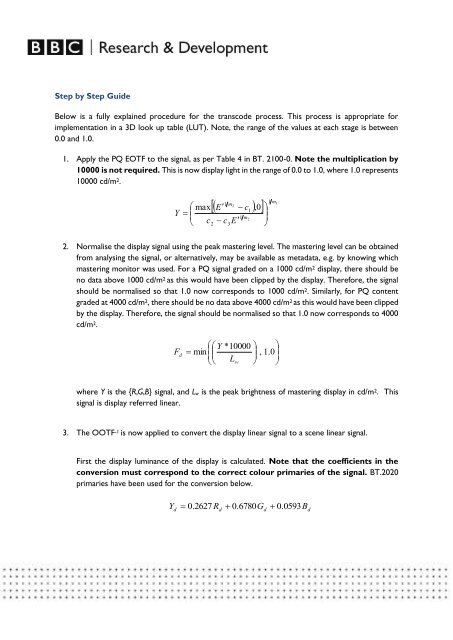Perceptual Quantiser (PQ) to Hybrid Log-Gamma (HLG) Transcoding
eJi2Pvtk
eJi2Pvtk
Create successful ePaper yourself
Turn your PDF publications into a flip-book with our unique Google optimized e-Paper software.
Step by Step Guide<br />
Below is a fully explained procedure for the transcode process. This process is appropriate for<br />
implementation in a 3D look up table (LUT). Note, the range of the values at each stage is between<br />
0.0 and 1.0.<br />
1. Apply the <strong>PQ</strong> EOTF <strong>to</strong> the signal, as per Table 4 in BT. 2100-0. Note the multiplication by<br />
10000 is not required. This is now display light in the range of 0.0 <strong>to</strong> 1.0, where 1.0 represents<br />
10000 cd/m 2 .<br />
Y<br />
max<br />
<br />
c<br />
1 m<br />
1 m<br />
1<br />
2<br />
E<br />
c ,0<br />
2<br />
<br />
c E<br />
3<br />
1<br />
1 m2<br />
<br />
<br />
<br />
2. Normalise the display signal using the peak mastering level. The mastering level can be obtained<br />
from analysing the signal, or alternatively, may be available as metadata, e.g. by knowing which<br />
mastering moni<strong>to</strong>r was used. For a <strong>PQ</strong> signal graded on a 1000 cd/m 2 display, there should be<br />
no data above 1000 cd/m 2 as this would have been clipped by the display. Therefore, the signal<br />
should be normalised so that 1.0 now corresponds <strong>to</strong> 1000 cd/m 2 . Similarly, for <strong>PQ</strong> content<br />
graded at 4000 cd/m 2 , there should be no data above 4000 cd/m 2 as this would have been clipped<br />
by the display. Therefore, the signal should be normalised so that 1.0 now corresponds <strong>to</strong> 4000<br />
cd/m 2 .<br />
F<br />
d<br />
<br />
<br />
<br />
Y *10000 <br />
min <br />
, 1. 0<br />
<br />
Lw<br />
<br />
where Y is the {R,G,B} signal, and L w is the peak brightness of mastering display in cd/m 2 . This<br />
signal is display referred linear.<br />
3. The OOTF -1 is now applied <strong>to</strong> convert the display linear signal <strong>to</strong> a scene linear signal.<br />
First the display luminance of the display is calculated. Note that the coefficients in the<br />
conversion must correspond <strong>to</strong> the correct colour primaries of the signal. BT.2020<br />
primaries have been used for the conversion below.<br />
Y 0.2627<br />
R 0.6780G<br />
0. 0593B<br />
d<br />
d<br />
d<br />
d


